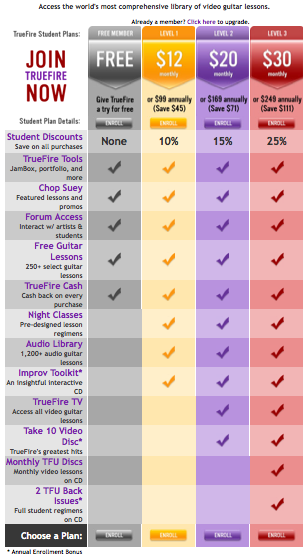What is the reference website and why is it a subscription website?

Subscription Plans Available at TrueFire.com
The subscription website model is simple: pay-for-access.
Most subscriptions are sold on a time interval basis. One-day memberships generally have the highest fee, while annual memberships usually offer the lowest price and offer the most benefits.
In this example, we see that TrueFire.com offers 4 levels of student enrollment plans for access to their library of video guitar lessons. Beginning with a free membership (which has limited access) up to level 3 (which gives a student full access). Plus, each level of membership offers an additional bonus gift when students sign up for the Annual Enrollee Plan.
There are 6 types of subscription websites, which are content driven and more often than not are user driven, but some are sponsor driven or a combination of both. User driven sites usually require the user to subscribe and pay for access for a designated period of time. They are designed primarily to serve the paid subscribers needs.
While there may be hundreds of individual and hybrid subscription websites being used, Mequoda studies the following six subscription websites archetypes:
Subscription Website Archetype #1: Reference Website – Lynda.com
Subscription Website Archetype #2: Membership Website – TheLadders.com
Subscription Website Archetype #3: Periodical Website – WSJ.com
Subscription Website Archetype #4: Newsletter Website – GolfOdyssey.com
Subscription Website Archetype #5: Application Website – Hoovers.com
Subscription Website Archetype #6: Magazine Website – Make.com
[text_ad]
The Reference Website
The Minimum Information Unit (MIU) may be an article, book, report, document, lesson or episode. While simple sites may rely solely on HTML and PDF files, many more robust sites also incorporate still photos, audio and video in the MIU. For some sites, an audio or video lesson or episode may be the primary MIU.
Consumer Reports, Lynda and Mequoda Pro are all benchmark sites for the Subscription Reference Website Archetype. Each requires registration and payment for full access.
Most real world subscription websites combine two or more of the above archetypes to create hybrid subscription websites with much success and functionality.
We are seeing more subscription websites launching with the increase of high quality eReaders, including the iPad, that are now available. We will probably continue to see an increasing number of publishers launch subscription websites just to meet user demands.


